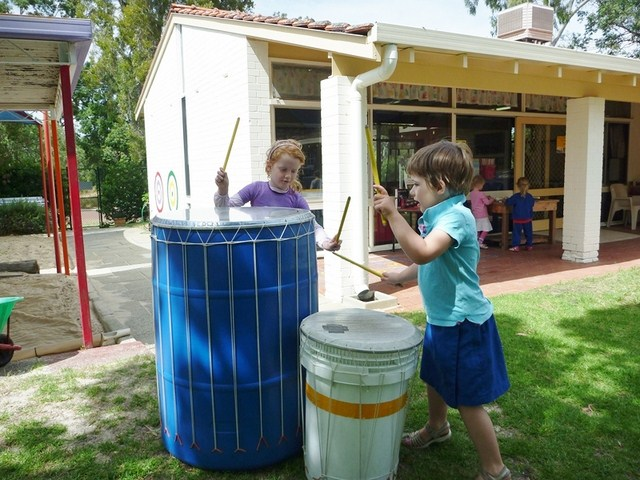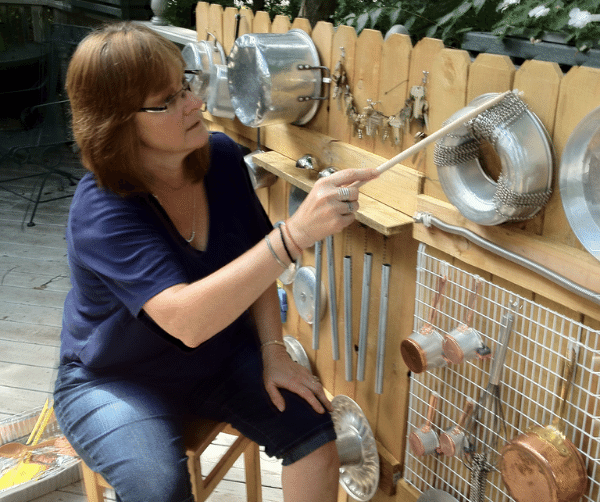Celebrating Outdoor Music & Outdoor Music Play

Image courtesy of Alec Duncan, ChildsPlayMusic.com.au
The joy of making music is clear as soon as a child hears a sound he has created on his own! Whether it’s the metallic rattle of a tambourine, a thud on a drum, or the clack of two sticks together, making music has a powerful and positive impact on most humans as early as infancy when a baby first kicks her feet to hear a gentle rattle from an activity gym or “jingle socks.”
At times, the din of sound exploration can get overwhelming inside a classroom, and teachers relegate it to one or two small (not too noisy!) instruments, or remove the opportunity for sound-making altogether to preserve the peace. Now that we are spending more time outdoors, why not encourage your children to create music outside, too? With a few simple adaptations your outdoor space can become a hot spot for exploration!
Benefits of Taking Music Outdoors
One benefit of taking music outdoors is the freedom to make loud sounds with less concern for disrupting others. The bigger the sound, the more physical energy a child uses! It also encourages gross motor activity as the space provides room for bigger movements, dance and exploration with added elements like large instruments, Music or Sound Walls, and even water-sound exploration.
Outdoor Musical Instruments
What musical instruments belong outdoors?
- All instruments should be durable and weather resistant (or easily replaceable, like cardboard)! Some “indoor” instruments are able to be used outdoors, too.
- Music/Sound Walls made of found items (can be added to or changed over time)
- Commercial or homemade large drums, cymbals, bells, shakers, guiros, tambourines, tone blocks or xylophones. The bigger the sound the better!
- Commercially available musical tools that are made for use outdoors
- Balancing Sound Bar
- A wide array of simple instruments you may make from recycled materials
Two ways to create effective musical exploration areas outdoors:
- Music (or Sound) Station: When possible, clear a permanent space for music exploration (designated grassy area, mats/tablecloth on the ground, or table). Select an area that allows for large motor movement and a collection of large and loud instruments, preferably away from other high-traffic areas. Consider these instrument options:
- various sized heavy corrugated cardboard boxes or tubes
- large drums (durable and weatherproof, e.g., empty 5 gallon+ buckets)
- unused garbage cans and lids
- Boomwhackers
- large wooden xylophone
- Music (or Sound) Walls - a stationary wall (existing or created), with objects for tapping and banging affixed or suspended. Music Walls can be as simple or as elaborate as you and your students desire.

Photo used by permission of Susan Nierman
Ways to hang instruments:
- stable, free-standing fence, section of fencing (see photo), or existing wall affixed with metal/wire grids or clothes hanging fixture
- free standing PVC pipe structure (any size or configuration; no need to glue!)
- wooden shipping pallet anchored to a wall or immovable item to prevent tipping
Sound and music-making items to hang or affix:
- metal cans of various sizes (ask restaurants or school kitchens for larger ones)
- PVC pipe in varying diameters cut into varied lengths
- washboards
- metal trash can lids
- old muffin tins, skillets, copper molds, baking sheets/pans
- metal kitchen utensils
- bells of all shapes and sizes
- tambourines
- plastic tubs or containers
- strings of keys, bolts, washers
- cookie or other tins (with and without lids)
- non-glass wind chimes
- large, thick rubber bands to affix between nearby tree branches for “plucking”
Include multiple mallets (“strikers” or “tappers”) for creating the sound, such as:
- long handled kitchen utensils
- homemade rubber mallets (a solid “bouncy ball” with a hole drilled and a length of ¼” diameter dowel glued into the hole)
- foam or rubber flip flop sandals for “whacking” the ends of PVC pipes
- fly swatters
Outdoor Music is a Full-Body Sensory and Cognitive Experience!
Dancing, banging, bouncing, clapping and tapping develop fine and large motor control and body coordination. All of these types of movements build important connections across the many regions of the brain to activate complex actions required for humans to survive and thrive.
The simple act of modeling a steady beat (the repetitive “heartbeat” or pulse of a song) helps children learn to regulate attention behaviors. Add to this any sort of language play such as a song, poem or chant, and children’s brains are lighting up in a multitude of areas including movement, language, and mathematics.
Consider combining movement, music and literacy by providing assorted books and familiar songs or chants that encourage motor skills, sound and language. Reprint song lyrics and chants onto poster board or laminated chart paper so that they may be hung and referred to in your outdoor music space. Paperback copies of books that are content-rich in action words and language play can be cut apart, pages laminated, bound back together and stored in durable baskets to make them available for outdoor use.
Adding options for children to explore language and movement makes outdoor music making one of the best opportunities to develop sensory well-being, body and brain. Unlike language alone, music experiences activate every subsystem of the brain, which explains, in part, why they are a predictor of overall success in school and beyond.
References:
Duncan, Alec. Take the Music Outside and Play.
Gardner, Howard. 2006. Multiple Intelligences: New Horizons in Theory & Practice.
Kay, Maria. 2013. Sound Before Symbol: Developing Literacy Through Music.
Ostrosky, Michaelene, et al. 2018. Palaestra, v. 32, no.1. Let’s Get Moving: Using Children’s Literature to Support Physical Activity and Readiness Skills.
Scholastic. Outdoor Activities: Movement and Music Making
Pentagon Play. 10 Wonderful Benefits Outdoor Musical Instruments Bring to Your Little Learners.
Resources:
Picture Books about sounds:
Baer, Gene. Thump! Thump! Rat-a-Tat Tat!
Beaumont, Karen. Wild About Us!
Brown, Dan. Wild Symphony.
Goldsaito, Katrina. The Sound of Silence.
Mills, J. Elizabeth. The Spooky Wheels on the Bus.
Rosenstock, Barb. The Noisy Paintbox: The Colors and Sounds of Kandinsky’s Abstract Art.
Odanaka,Barbara. Smash! Mash! Crash! There Goes the Trash!
Underwood, Deborah. The Loud Book!
Books for children about the science of sound:
Pfeffer, Wendy. Sounds All Around.
Trumbauer, Lisa. All About Sound.
Waring, Geoff. Oscar and the Bat.
Picture books that encourage movement:
Carle, Eric. From Head to Toe (Big Book)
Cauley, Lorinda. Clap Your Hands.
Gardner, Lindsay. Whoosh Around the Mulberry Bush.
Kalan, Robert. Jump, Frog, Jump!
Page, Robin. Move!
Root, Phyllis. One Duck Stuck. (Big Book)
Read also:
Making Noises Joyful: Benefits of Outdoor Music Experiences
Lisa Heintz, M.Ed., is an educator with over 25 years of experience supporting learners from toddlers to adults, and owner of Little Songbird: Songs for Learning, a site that provides quality children’s music and book recommendations for PreK-grade 3 educators. She stays “green and growing” by volunteering in community and school projects that focus on Diversity, Equity and Inclusion, as well as with the Children’s Music Network. She is fascinated by birds of all sorts, loves cats, and is the proud mom of a son who is a shining example of what intentional teaching and parenting can do for children with disabilities. Connect with Lisa at Lisa@LittleSongbird.com.
